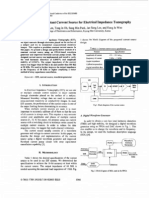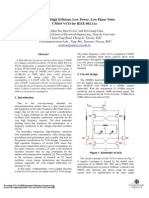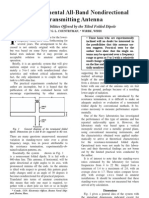Low Power Cmos Vga
Low Power Cmos Vga
Uploaded by
Mohammad Ayatullah MaktoomCopyright:
Available Formats
Low Power Cmos Vga
Low Power Cmos Vga
Uploaded by
Mohammad Ayatullah MaktoomOriginal Description:
Original Title
Copyright
Available Formats
Share this document
Did you find this document useful?
Is this content inappropriate?
Copyright:
Available Formats
Low Power Cmos Vga
Low Power Cmos Vga
Uploaded by
Mohammad Ayatullah MaktoomCopyright:
Available Formats
370
IEEE TRANSACTIONS ON CIRCUITS AND SYSTEMS-11:
ANALOG AND DIGITAL SIGNAL PROCESSING, VOL. 42, NO. 6, JUNE 1995
A Low-Power CMOS VGA for 50 Mb/s Disk Drive Read Channels
Ramesh Harjani, Member, IEEE
Abstract- We describe an all CMOS variable gain amplifier (VGA) suitable for use in disk drive read channels. The VGA maintains a 3 dB bandwidth greater than 85 MHz throughout its gain range. This ensures good phase linearity for data transfer rates of up to 50 Mbls. The VGA provides a 25 dB gain variation along an ideal exponentialgain to control voltage curve and 30 dB of gain control if ideal exponential characteristicsis not absolutely necessary. The VGA achieves the necessary exponential gain to control voltage characteristics intrinsically using only MOS transistorsas a single unit to reduce power and area consumption. Overall power consumption is less than 10 mW for the VGA circuit excluding the off-chip buffer circuits.
-1.0
-0.6
-0.2
0 . 2
0.6
1.O
Fig. 1. Exponential gain versus control voltage.
I. INTRODUCTION
HE desire for smaller disk drives with reduced power consumption increases the need to integrate the read channel electronics into a single mixed-signal CMOS chip or a set of chips. Variable gain amplifiers (VGA) form an important component of the read channel and help stabilize the voltage supplied to the detector and filter sections of the read channel. Standard bipoiar VGAs [ l ] dissipate lots of power and previous attempts at developing a CMOS compatible VGA [2] have resulted in variable gain amplifiers with the necessary gain control characteristics but still dissipating substantial power. A significant percentage of this power is dissipated in generating the exponential current output for a linear voltage input. The exponential gain to linear control voltage characteristic is preferred for read channel automatic gain control loops [1]-[4] to minimize variations in the output voltage. Here we present a methodology for generating the desired exponential transfer characteristics intrinsically using only MOS devices within the variable gain amplifier structure. It is usually not possible to operate the MOSFET in the weak inversion region because of the high frequencies involved in the signal path of read channels. Therefore, for these frequencies in CMOS there is no intrinsic logarithmic device transfer characteristics that can be exploited to generate the necessary exponential gain to linear control voltage characteristic desired. One possible methodology to generate this exponential characteristic is to use the parasitic lateral bipolar transistors available in CMOS 121, 151, 161. An alternate methodology, being presented here, is to use the exponential gain control behavior presented by the function
Manuscript received October 6, 1993; revised November 30, 1994. This paper was recommended by Associate Editor M. Steyaert. The author is with the Department of Electrical Engineering, University of Minnesota, Minneapolis, MN 55455 USA. IEEE Log Number 9411334.
Gain =
H}
(1 + x ) 2 (1 - x)2
Gain range =
This expression is plotted in Fig. 1, where the y scale is in dBs. It is possible to see that the gain expression in (1) provides the necessary exponential transfer Characteristics and shows a good match for -0.7 < x < 0.7. Further, it can be shown that the maximum gain range is given by (2). Therefore, for a gain range of 30 dB the value of x needs to be varied from -0.698 to +0.698. As just mentioned, the exponential characteristics matches fairly well within this range. Outside 0.7) ~ the rate of change in gain is even this region ( - 0 . 7 ~ more rapid. As it turns out this provides even better control of the output voltage in comparison to a simple exponential gain characteristics. A comparison of the output voltage produced using the normal exponential scheme and our scheme is shown in Fig. 3. The system level block diagram, shown in Fig. 2, for the automatic gain control loop was used to obtain the voltages in Fig. 3. The value of error voltage amplification, K , was set to 1. A higher value of K would lead to better output control for both schemes. However, for comparison purposes any value is appropriate. For the two schemes only the transfer function block between E, and A was changed. We note in Fig. 3 that at both higher and lower input voltages our scheme performs better than an ideal exponential in maintaining a constant output voltage. Therefore, the value of z could be varied beyond f0.7. However, varying z beyond these limits has detrimental affects on bandwidth and phase characteristics and is discussed later.
1057-7130/95$04.00 0 1995 IEEE
HARJANI: LOW-POWER CMOS VGA
37 1
Fig. 2. Automatic gain control circuit used to compare VGA's.
two source follower stages to drive external loads of 5 pF, as in [2]. During normal operation the VGA will be followed by other on-chip circuitry, usually a detector, and the source follower stages can be dropped. A careful look at the first two stages will show that they are vertically flipped mirror images of each other. For example, transistors Q7 and QS provide the same functionality for the second stage as do transistors Q3 and Q4 for the first stage. This allows the circuit topology to be extended from one variable g i n stage to n variable gain stages, where the value of n is only limited by power consumption, circuit noise and the total phase contribution. Increasing the number of stages increases the range of gain variability possible. For example, four such stages could be used to provide 60dB of gain variability. As both the gain control stages operate similarly we will discuss only the first stage. Transistors Q3 and Q4 are diode connected and operate as the load transistors for the differential pair Q1 and Q2. The gain for the first stage is controlled by the ratio of the transconductances of Q2 and Q4 (and Q 1 and Q 3 ) , {gainstagel = ( g r n 2 / g r n 4 ) } . The ratio of their transconductances can be varied by changing the ratio of the currents that pass through Q2 and Q4. The current flowing through Q2 and Q4 are given by
Fig. 3. Output voltage produced using exponential and [(l-x)/(l+x)] schemes.
11. CIRCUIT DESIGN
For a CMOS process the ((1 z ) / ( l - z)} function, displayed in Fig. 1, can be generated by dynamically varying the saturation region transconductance or the triode region resistance of a transistor [7], [8]. The triode region resistance can be changed by altering the gate voltage of a MOS device while the saturation region transconductance can be controlled by altering the drain-to-source current through the device. We have selected to use the current control technique, i.e., we alter the transconductances of transistors to generate the desired function. Unfortunately, the transconductance of the MOS device varies only as the square root of the drain current such that a single gain stage would only provide 15dB of gain variation for z changing from -0.7 to +0.7. By varying the current through a transistor we are altering its transconductance. Unfortunately, a change in the transconductance also affects the bandwidth of the amplifier stage. An increase in the bandwidth has little effect, as will be seen later, however a reduction in the bandwidth of the gain altering stage affects the bandwidth of the entire system. Reducing z to less than -0.7, therefore, reduces the overall bandwidth. Additionally, from Fig. 1, we note that changing z beyond f0.7 causes the system gain to vary from the desired exponential characteristics. It, therefore, becomes necessary to use two stages of gain control to achieve the necessary gain range. Fig. 4 shows a simplified circuit schematic for the complete variable gain amplifier. The first two stages of this circuit provide the necessary gain variation. The third stage stabilizes the common mode voltage, provides a relatively large fixed differential mode gain and also helps to stabilize the group delay through the amplifier. The third stage is followed by
The gain of the first stage can therefore be altered by changing the value of the current 11 and is equal to
The left half of the gain expression given by (5) is a function of device sizes and process parameters and is a constant during normal use. The right half has the form J(l z)/(1- z). As mentioned earlier, except for the square root this expression has the exact form we desire. To compensate for the square root we use two stages and vary the current I1 from -0.7Ib to +0.7Ib to achieve the necessary 30 dB of gain variation. Currently a simple class-A current amplifier is used to generate the current I1. Alternately, a class-AB current amplifier design [9] can also be used and will further help reduce power consumption. However, care must be taken to reduce crossover distortion or VGA gain hunting is likely to occur. The voltage sources ( V , f f )are included to allow the current sources of the second and third stages to operate in the saturation region. The value of 0.4 V for this offset voltage is selected such that it is greater than the (Vgs- &) of the current sources but is small enough such that it does not have much impact on the input common mode range of the VGA.
372
IEEE TRANSACTIONS ON CIRCUITS AND SYSTEMS-11:
ANALOG AND DIGITAL SIGNAL PROCESSING, VOL. 42, NO. 6, JUNE 1995
, +&,
Fig. 4. Complete variable gain amplifier schematic.
Fig. 6. Offset voltage versus load current.
Fig. 5. Circuit used to generate offset voltage.
This offset voltage is generated using a feedback scheme that provides a low impedance voltage source and is shown in Fig. 5. Fig. 6 shows the SPICE simulation results for the offset voltage generator. When the load current approaches 100 nA the offset voltage rapidly rises to 0.4 V and then remains fairly steady even when the load current increases to 100 P A . If common mode range is not of concern then a simple diode connected transistor can be used instead. Transistor Q 3 2 is operated in the subthreshold region and transistors Q 3 1 , Q 3 3 and Q 3 4 are operated in strong inversion. Transistor Q 3 4 is in the triode region and acts as a resistive load for transistor Q 3 2 . The low resistance at this node is included to stabilize the loop by increasing the pole frequency formed at the drains of Q 3 2 and Q 3 4 . As soon as the gate to source voltage of Q 3 2 is sufficiently large (approximately equal to V o f f the ) drain current of Q 3 2 increases and pulls up the gate of transistor Q 3 3 . This in turn rapidly increases the gate to source voltage of transistor Q31 and V o f fdoes not increase beyond the desired value. The circuit in Fig. 5 functions in manner that is similar to a series voltage regulator except here we fix the voltage drop across the load transistor rather than the output voltage. Since the necessary Awgs, (Augs = Vgs- G), is small the turn on voltage for transistor Q 3 3 is approximately equal to I & . Using this constraint, the desired offset voltage, V o f f , can be set using (6).
Here UT is equal to KTIq which is approximately equal to 26mV at room temperature, the slope factor 17 is usually between 1.3 and 2 and is fairly controllable [lo], Kk is the transconductance parameter for NMOS transistors, W32, L 3 2 , W 3 4 and L 3 4 are the widths and lengths of transistor Q 3 2 and Q 3 4 . Id0 is a process dependent parameter and is highly unpredictable. However, Ido affects the offset voltage only logarithmically such that a 100% variation in Id0 only causes a 6% variation in the offset voltage. The other parameters are likely to have much smaller variation. The loop gain for the offset voltage generator with a load capacitance of 5 pF is shown in Fig. 7 and the closed loop source impedance of the generator is shown in Fig. 8. The source impedance of a diode connected, 1 lgm, transistor is also shown in Fig. 8. We note that the source impedance for the offset voltage generator is lower than that for the diode connected transistor for low frequencies (36 0s) and increases at higher frequencies. This results in a slight degradation of the CMRR at these frequencies. However, as mentioned earlier, the dc voltage drop across the diode connected transistor is larger. An expanded view of the third stage is shown in Fig. 9. Previously, transistors Q I I , Q12, Q15. &I69 Q19 and Q20 were omitted from Fig. 4 for clarity. Transistors Q 1 5 and QIS are identical in size to Q 9 and Q ~ and o are used to cancel the Miller multiplication effect. Transistors Q 1 9 and Q 2 0 are primarily included to reduce the negative feedback effect of the transistors Q 1 5 and QIS [ 141. However, they also function to reduce the gate-to-source capacitive loading effects of transistors and Q 1 6 . The third stage is set to have a large gain as a result of which the drain-to-gate capacitance
HARJANI: LOW-POWER CMOS VGA
313
30.
e.
5 1
0'
-50 i
I
Fig. 1 1 . Simplified schematic for gain reduction calculation.
R q w y (HZ1
effective gate referred capacitance for this circuit is given by (7), where A is the gain of the third stage. When transistors Q9 and Q15 are matched this equation can further be simplified to (8).
10
1 . a
103
la(h
1 . M
1 m
Fig. 8. Offset voltage generator source impedance.
Fig. 9. Expanded view of the third stage.
Fig. 10. Simplified schematic for capacitance calculation.
( c d s ) of Q9 and Qlo get Miller multiplied and lowers the bandwidth of the second stage. Traditionally, cascoding [5] is used to reduce the Miller multiplication effect. Unfortunately, cascoding also limits the maximum swing possible from the amplifier. For this reason we use the partial positive feedback scheme to reduce Miller multiplication effects. A simplified schematic to calculate the effective gate referred capacitance of the third stage is shown in Fig. 10. It can be shown that the
In comparison, the gate referred capacitance for the regular cascode technique is equal to 2Cgd + Cgs and the gate referred capacitance for a noncascode noncanceled circuit is equal to Cgs (1 A)Cgd. Unlike normal cascoding techniques, the addition of the two extra transistors Q15 and Q ~ s increases the gate-to-source capacitances slightly. However, the effect of this is much smaller than the effect caused by Miller multiplication because of the large gain associated with the third stage. For example, for our circuit for a value of llgdslg = 50K the effective gate referred capacitance is only 12% larger than for a regular cascode. As shown in (7) it is important that the two capacitances Cgdg and Cgdl5 match fairly well for complete cancellation. The gate to drain capacitance is a function of the lateral diffusion of the drain junction and is highly process dependent. Therefore, it is important that identical methods be used to generate both capacitances. We use identical device sizes for this purpose. The drain-to-gate capacitances of transistors Q15 and Q16 are used to cancel the effects of the drain-to-gate capacitances of Q9 and &io. Unfortunately, transistors Q15 and Q16 also provide negative feedback which reduces the gain of the third stage. For this reason values for gdslg and gdsao are selected such that the transconductances of transistors Q15 and are much smaller than those of Q9 and &lo. Therefore, the gain is only reduced slightly. The resulting effective transconductance is given by (9). Since the sizes of Qg, &lo and &IS, Q ~ F , are the same their transconductance is set by the current flowing through them. The relationship between the currents trough Q9 and QIS are given by (10). For our design the reduction
+ +
314
IEEE TRANSACTIONS ON CIRCUITS AND SYSTEMS-11: ANALOG AND DIGITAL SIGNAL PROCESSING, VOL. 42, NO. 6, JUNE 1995
5.0
io
-5.0
Frrquacy (&)
1. Ih
\
IC"
]
l.ffih
loMh
Fig. 12. Bandwidth of the second stage with and without Miller cancellation.
in the transconductance is approximately four percent. At extremely high frequencies the gain of the third stage becomes sufficiently small due to its own bandwidth limitations and the Miller multiplication effect becomes insignificant. In Fig. 12 we plot the gain versus frequency for the second stage with and without our Miller cancellation circuit. The heavy line shows the result after Miller effect cancellation and the thin line shows the result without any cancellation. In this figure we note the reduction in gain due to Miller multiplication and also the reduction of this multiplication effect at higher frequencies. We also note that the plot is smoother after cancellation, i.e. more constant group delay. The Miller multiplication effect The common mode gain for a completely balanced circuit has been canceled but there is a slight reduction in the overall bandwidth due to the increase in the gate-to-source is ideally zero. However, any imbalance between the two capacitance. The transistors Q15 and Q l s primarily affect the sides results in some nonzero common mode gain. This is high frequency ac behavior and so the overall circuit can illustrated in Fig. 18. For this simulation the threshold voltage effectively be simplified by removing Q 1 5 , Q 1 6 , Q 1 9 and Q ~ o of transistor Q9 was altered by 1 0 m V . We note both a nonzero and assuming that the gate-to-drain capacitances of transistors common mode gain and also the beneficial effect of adding Q 9 and Q ~ are o zero and that the effective transconductance C,. Though a complete analysis for common mode gain is not provided as this would entail listing the influence of are reduced slightly. of Q15 and each transistor in the third stage and all of their parameters. However, an qualitative explanation can be provided for the V t offset situation just mentioned. Other situations can be analyzed similarly. The common mode gain for each half of the circuit is given by the ratio of the conductances g o / g l . Here g o is the conductance of the current source I L and gl is the effective conductance looking into the drain of transistor Q17 with the common mode feedback circuit being functional. The low frequency value of g l is given by ( g m 1 7 g m l 3 ) / ( g d s l 3 g m 1 7 ) . The offset voltage is amplified by the gain of the third stage and causes the two output voltages to be different. This in turn causes the effective g l The output stage is designed to provide a large bandwidth of the two halves to be different. The transconductance of and large dynamic range at low distortion. This is achieved Q17, ( g m 1 7 ) , essentially remains the same because of the by using transistors Q11 and Q12 in the triode region. Two extremely small change in the current due to this change in transistors are used instead of one to cancel higher order the output voltage. Likewise, the transconductance of Q13, signal distortion due to variations in threshold voltage as a g m 1 3 = l ( k k W / L ) V d s l 3 1 , also essentially remains the same result of changes in the source to bulk voltage, ( V s b ) of the as the V d s is maintained constant by the common mode load transistors. The circuit topology also allows for some feedback effect. However, the conductance of Q 1 3 , g d s 1 3 = independent control of the differential mode and common ( k L W / L ) ( I V g s l 3 1 - IVt,l- I V d s 1 3 ( ) ,changes because V g s 1 3 mode gain and bandwidths. The midpoint between the two changes due to the difference in the two output voltages. This transistors is fairly constant for differential mode signals. causes the conductance looking into the drain of Q17 to be Therefore, C, has no effect. However, for common mode different for that looking into the drain of & I S . Therefore, the signals C, acts as an additional load. Transistors Q13 and Q14 gains of the two halves are not equal and this results in the provide common mode feedback and control the dc voltage nonzero common mode gain. at the outputs of the third stage. This topology for common Due to the fully differential structure of the VGA any mode feedback [ll], [12] is particularly attractive for high common mode signal at the input of the first stage is severely
frequency applications and provides a number of advantages when compared to other topologies [ 121, [ 131. First, the circuit does not add any additional high impedance nodes in the circuit that can add phase and affect the stability of the common mode feedback loop. Second, the two transistors Q13 and Q14 operate in the triode region and provide a low impedance node at the source nodes of transistors Q17 and Q18. The differential mode gain for this stage is set by the triode operated transistors Q11 and Q1Z and is given by (1 1). As mentioned earlier for differential mode signals C, has no effect. Additionally, for differential mode signals the common mode feedback circuit has no small-signal effect and the impedance looking into the drains of Q17 and Q 1 8 are high. Therefore, the primary resistive load at the outputs is approximately equal to the inverse of the conductance of Q11 and Q 1 2 . Therefore, the bottom half of the circuit can be replaced with a simple differential pair with zero gate to drain capacitance and slightly lower transconductance.
HARJANI: LOW-POWER CMOS VGA
375
attenuated by the first two stages before it gets to the output stage, i.e., the overall VGA has a fairly high common mode rejection ratio (CMRR). Therefore, one of the primary purposes of the common mode feedback circuit in the output stage is to stabilize the output voltage in the face of process and temperature variations. The primary source of such variations are possible changes in the threshold voltages of the transistors, particularly those of Q9 and Q13. It also serves to reject any other common mode signals that may arrive at the third stage via the supplies or the substrate. Additionally, because of the complete symmetry maintained throughout the design the power supply rejection ratio is extremely high for this circuit. The gain of the VGA is controlled by varying the current 11. However, these variations in the current 1 1 affect the transconductances of the differential pairs and diode connected loads as well. This change in the load transconductances also affects the bandwidth of the first two stages. To reduce the effects of this change in bandwidth on the overall group delay the bandwidths of the three stages are selected so that the bandwidth of the first two stages is much larger than the bandwidth of the third stage. Therefore, the bandwidth of the overall amplifier is dominated by that of the third stage, which is kept constant. One of our design goals is to maintain a fairly constant group delay through the system. In general, the variation in the group delay is minimized by maintaining the poles close to the real axis. For a three stage system like ours the delay through the system is given by (12). Here, w is the frequency in radians and w1, w2 and w3 are the three system poles. The variation in the group delay with frequency cannot be made to be equal to zero for such a system. However, it can be minimized within a frequency band by setting the values of w2 and w3 to be approximately equal to 2.23 times w1. This value was generated by settting w2 = w3 and finding the minimum of the derivative of (12). In our system, the third stage pole is selected to have the lowest frequency as this pole frequency does not change with gain settings. The poles of the other two stages are selected to be close to 2.23 times the third stage pole.
Fig. 13. Amplifier gain in dB versus control voltage.
We shall see the effects of these and other design choices in the results presented in the next section. 111. RESULTS
AND
CONCLUSION
The results presented in this section were generated with the help of HSPICE simulations. Simulations were done using both BSIM and level 2 models. The results presented here are primarily those from BSIM models. However, BSIM models tend to be pessimistic about output conductance so results were also confirmed using level 2 models. Unfortunately, level 2 simulations have the limitation that the transconductance is discontinuous with respect to current. Layout parasitic estimates were also included in these simulations. These
parasitic estimates were generated by completing a layout for a slightly earlier pass design using the Magic layout editor. The current circuit has been designed for the generic MOSIS 2 micron process. Three dB bandwidths greater than 85 MHz was achieved throughout the gain range. Fig. 13 shows the gain in dB versus the control voltage and Fig. 14 shows the group delay at 50 MHz versus the control voltage for the variable gain amplifier. From Fig. 13 we find that we were able to generate the desired exponential gain versus control voltage relation. Though we do achieve the 30 dB of variation we see some deviations from the ideal exponential characteristics. We are able to obtain approximately 25 dB variation of gain along the ideal exponential relationship. However, as mentioned earlier, this is an advantage rather than a disadvantage. The slight reduction in the overall gain range (from ideal exponential gain to control voltage characteristics) as compared to the expression described in (1) is due to channel modulation and other short channel effects not included in (1). These effects reduce the effective transconductance for the transistors that control the gain in the first two stages. It is expected that these minor variations from the ideal behavior, as long as they are not abrupt, is unlikely to cause any major problems for the automatic gain control loop. In Fig. 14 we find that the group delay is relatively constant with control voltage changes. In Fig. 15 we show a 3 dB bandwidth of 109 MHz for a control voltage of 0.7 V. Fig. 16 shows the phase versus frequency for the amplifier. To maintain a constant group delay through the amplifier it is necessary that the phase increase linearly with frequency. In Fig. 16, we see that the phase increases linearly with frequency till about 200 MHz which clearly suffices for our operating bandwidth. Fig. 17 shows the harmonic content at the output of the amplifier for a 1.2VP-, output signal at 50MHz. The first two stages use diode connected loads which have large quadratic nonlinearities. Additionally, each of the differential pairs generate quadratic nonlinearities. However, we note that the even harmonics are completely suppressed as might be expected in a fully differential design. The total harmonic distortion for the overall amplifier was less than 0.7% for a 1.2Vp-, output signal. One of the primary advantages of generating the exponential gain characteristic intrinsically, rather than use a lateral bipolar, is the reduction in power consumption. For example, the total power consumption for our VGA without the source follower stages is approximately 10 mW. This is approximately a order of magnitude lower than the power
376
IEEE TRANSACTIONS ON CIRCUITS AND SYSTEMS-11:
ANALOG AND DIGITAL SIGNAL PROCESSING, VOL. 42, NO. 6. JUNE 1995
.
4M
01
.
0.5
.
0.8 1.1 11
Fig. 14. Group delay versus control voltage.
-1
larger in comparison to an all bipolar implementation [I]. The current design has been designed to operate at 50 Mb/s. However, it is expected that the basic design can be extended to higher frequencies by going to smaller geometries and/or by increasing the power. Additionally, a larger range in gain variability can be accommodated by increasing the number of of stages. We have described a low-power CMOS variable gain amplifier that uses only MOS devices to generate an exponential gain versus control voltage characteristic necessary for read channel electronics. This paper introduces a number of novel techniques that are used to generate the exponential gain behavior, increase bandwidth, provide a voltage drop less than the threshold voltage and stabilize the group delay.
REFERENCES
[ 11 AD600/AD602 dual low-noise wideband variable gain amplifier,
4 0
F h u m a (Hr)
1 -
1 . m
1OMb
1 . m
\]
Fig. 15. 3 dB frequency for amplifier.
Fig. 16. Accumulated phase for amplifier.
--I
1.0mv-
I I
,/-
Fig. 17. Total harmonic distortion of overall amplifier.
-30
Analog Devices Data Sheet. [2] R. Gomez and A. A. Abidi, A 50 MHz variable gain amplifier cell in 25 p m cmos, in CICC, 1991. [3] H. Sato, T. Okabe, K. Michii, and R. Sakano, Subsystem ics for Winchester disk drive, in IEEE Custom Integraf. Circuifs Con$, 1985. [4] AD890 precision, wideband channel processing element. Analog Devices Data Sheet. [5] R. Gregorian and G. Temes, Analog MOS Integrated Circuits for Signal Processing. New York: Wiley, 1986. 161 T.-W. Pan and A. A. Abidi, A variable gain amplifier using parasitic bipolar transistors in cmos, IEEE J. Sulid-Srute Circuils, vol. 24, Aug. 1989. [7] K. Nagraj, New cmos floating voltage-controlled resistor, Electron. Lett., vol. 22, 1986. [8] B. Nauta, E. Klumperink, and W. Kruiskamp, A cmos triode transconductance, in Inf. Symp. Circuifs Sysr., IEEE, 1991, pp. 2232-2235. [9] 2. Wang, Wideband class AB (Push-Pull) current amplifier in cmos technology, Electron. Letf., pp. 543-545, Apr. 1990. [IO] E. C. Vittoz, Micropower Techniquesin Design of MOS VU1 Circuitsfor Te[ecommunications, Y . Tsividis and P. Antognetti, Eds. Englewood Cliffs, NJ: Prentice-Hall, 1985, ch. 4. [ l l ] T. Choi, R. Kaneshiro, R. W. Broderson, P. R. Gray, W. Jett, and M. Wilcox, High-frequency cmos switched-capacitor filters for communications applications, IEEE J. Solid-state Circuits,vol. 18, pp. 652664, 1983. [I21 J. Duque-Camillo, Control of common-mode component in cmos continous-time fully differential signal processing, Analog Integrated Circuits and Signal Processing. New York Kluwer Academic, 1993, pp. 131-140. [13] P. Wu, R. Schaumann, and P. Latham, Design considerations for common-mode feedback circuits in fully-differential operational amplifiers with tuning, in IEEE Int. Symp. Circuits Sysf., pp. 1363-1366, 1991. [I41 Z. Czamul and Y. Tsividis, MOS tunable transconductor, Electron. Lett., vol. 22, pp. 721-722, June 1986.
9
-50
1.
Ral-9
h
Ion[h
ow
lOMh
1
1 m
Fig. 18. Effect of Cm on common mode gain.
consumption for a variable gain amplifier that uses the parasitic lateral bipolar device [2]. And the power savings are even
Ramesh Harjani (S87-M89) received the B.Tech, M.Tech, and Ph.D. degrees in electrical engineering in 1982, 1984, and 1989 from Birla Institute of Technology and Science, Pilani, India, the Indian Institute of Technology, New Delhi, and Camegie Mellon University, Pittsburgh, PA, respectively. He was with Mentor Graphics Corporation, San Jose, CA, until 1990 when he joined the Department of Electrical Engineering at the University of Minnesota, Minneapolis, where he is currently employed. His research interests include analog CAD techniques, low power analog design, disk drive electronics and analog and mixed-signal circuit test. Dr. Harjani received the National Science Foundation Research Initiation Award in 1991, and a Best Paper Award at the 1987 IEEWACM Design Automation Conference.
You might also like
- An IC Operational Transconductance Amplifier (OTA) With Power CapabilityDocument11 pagesAn IC Operational Transconductance Amplifier (OTA) With Power CapabilityhakimshujaNo ratings yet
- A High Gain Amplifier Using A Cascading Architecture: Iowa State University 348 Durham Center Ames, Iowa 50011, USADocument4 pagesA High Gain Amplifier Using A Cascading Architecture: Iowa State University 348 Durham Center Ames, Iowa 50011, USAKesani Venkat Narsimha ReddyNo ratings yet
- 01012833, Technical PaperDocument4 pages01012833, Technical Paperindresh.vermaNo ratings yet
- Practical Feedback Loop Design Considerations For Switched Mode Power SuppliesDocument14 pagesPractical Feedback Loop Design Considerations For Switched Mode Power SuppliesDiego PhillipeNo ratings yet
- Final Report File New - ShalniDocument51 pagesFinal Report File New - Shalnivickram jainNo ratings yet
- AS3842Document10 pagesAS3842kik020No ratings yet
- Precision Constant Current Source For Electrical Impedance TomographyDocument4 pagesPrecision Constant Current Source For Electrical Impedance Tomographyjorgeluis.unknownman667No ratings yet
- Research PaperDocument10 pagesResearch PaperVikas PatelNo ratings yet
- 300 W MOSFET 144 MHZ PA - Final VersionDocument41 pages300 W MOSFET 144 MHZ PA - Final Versionxe1kyaNo ratings yet
- High Gain GBW and SR P 5mWDocument8 pagesHigh Gain GBW and SR P 5mWLucas Compassi SeveroNo ratings yet
- Compensation Method Peak Current Mode Control Buck AN028 enDocument13 pagesCompensation Method Peak Current Mode Control Buck AN028 ensadqazwsxNo ratings yet
- Pim Control Method of Multiple Inverters: MaclevDocument6 pagesPim Control Method of Multiple Inverters: Maclevalpe_huandvNo ratings yet
- Devendra Singh Kushwaha: Topic-A Novel Approach To Designing of Low Power Operational AmplifierDocument31 pagesDevendra Singh Kushwaha: Topic-A Novel Approach To Designing of Low Power Operational AmplifierHarish KumarNo ratings yet
- A High Efficiency Boost Converter For TFT-LCD Bias SupplyDocument4 pagesA High Efficiency Boost Converter For TFT-LCD Bias SupplyHamid BoualiNo ratings yet
- A Mosfet-Only Dac For A General Array Configured Device: E. Montane, G. Hornero, G. Chapinal, J. SamitierDocument5 pagesA Mosfet-Only Dac For A General Array Configured Device: E. Montane, G. Hornero, G. Chapinal, J. SamitierMiguel BrunoNo ratings yet
- A Novel Slew-Rate Enhancement Technique One-Stage Operational AmplifiersDocument4 pagesA Novel Slew-Rate Enhancement Technique One-Stage Operational AmplifiersShubham SharmaNo ratings yet
- A 6-b 1-GS/s 30-mW ADC in 90-nm CMOS Technology: Yuan-Ching Lien and Jri Lee National Taiwan University, Taipei, TaiwanDocument4 pagesA 6-b 1-GS/s 30-mW ADC in 90-nm CMOS Technology: Yuan-Ching Lien and Jri Lee National Taiwan University, Taipei, TaiwanSunil PandeyNo ratings yet
- A 1.8V 12-Bit 230-MS/s Pipeline ADC in 0.18 M CMOS TechnologyDocument4 pagesA 1.8V 12-Bit 230-MS/s Pipeline ADC in 0.18 M CMOS Technologyfaithfully_fatihNo ratings yet
- A High-Speed High-Resolution Latch Comparator For Pipeline Analog-to-Digital ConvertersDocument4 pagesA High-Speed High-Resolution Latch Comparator For Pipeline Analog-to-Digital ConvertersJessyNo ratings yet
- 1.8 V - 100 MHZ CMOS Programmable Gain AmplifierDocument4 pages1.8 V - 100 MHZ CMOS Programmable Gain AmplifierKienha LuongNo ratings yet
- Ieee Current ModeDocument7 pagesIeee Current ModepqqpNo ratings yet
- D 119Document35 pagesD 119Mohammad Ayatullah MaktoomNo ratings yet
- A Linear Programmable Gain Amplifier For Biomedical ApplicationsDocument4 pagesA Linear Programmable Gain Amplifier For Biomedical ApplicationsInternational Journal of Application or Innovation in Engineering & ManagementNo ratings yet
- A 45 DB Variable Gain Low Noise MMIC AmplifierDocument4 pagesA 45 DB Variable Gain Low Noise MMIC AmplifierutilitytrackNo ratings yet
- Cascode Amp DesignDocument5 pagesCascode Amp DesignTamás BenyácsNo ratings yet
- A High Slew-Rate Push-Pull Output Amplifier For Low-Quiescent Current Low-Dropout Regulators With Transient-Response ImprovementDocument5 pagesA High Slew-Rate Push-Pull Output Amplifier For Low-Quiescent Current Low-Dropout Regulators With Transient-Response ImprovementsonofalexanderNo ratings yet
- Implementation of DSP Based Sinusoidal Pulse Width Modulation For Three Phase InverterDocument9 pagesImplementation of DSP Based Sinusoidal Pulse Width Modulation For Three Phase InverterIJSTE100% (1)
- Sliding Mode Control of SMPS: Ms. A. Jonisha, Mrs. V. Devi MaheswaranDocument11 pagesSliding Mode Control of SMPS: Ms. A. Jonisha, Mrs. V. Devi MaheswaranInternational Organization of Scientific Research (IOSR)No ratings yet
- PSRRDocument8 pagesPSRRAkhil MehtaNo ratings yet
- Compensators For The Buck Converter: Design and AnalysisDocument25 pagesCompensators For The Buck Converter: Design and AnalysisÖzgür YılmazNo ratings yet
- Class-C Power Amplifier Design For GSM ApplicationDocument5 pagesClass-C Power Amplifier Design For GSM ApplicationJose David CastroNo ratings yet
- CMOS Band-Pass Filter With Adjustable Center FrequencyDocument19 pagesCMOS Band-Pass Filter With Adjustable Center FrequencySerdar BenderliNo ratings yet
- Rectifier Power Factor and Pulse-Width Modultion Controlled Rectifier CircuitsDocument23 pagesRectifier Power Factor and Pulse-Width Modultion Controlled Rectifier Circuitsflo72afNo ratings yet
- A High Gain, Fully Differential Single Stage Folded Cascade Op-Amp With 1GHZ BandwidthDocument5 pagesA High Gain, Fully Differential Single Stage Folded Cascade Op-Amp With 1GHZ BandwidthJournal of Telecommunications0% (1)
- An 1162Document36 pagesAn 1162naniknanikNo ratings yet
- K 203Document5 pagesK 203Alexandre S. CorrêaNo ratings yet
- Eee 523 ProjDocument12 pagesEee 523 ProjBodhayan PrasadNo ratings yet
- Changing The Operating Frequency of An RF Power Amplifier CircuitDocument5 pagesChanging The Operating Frequency of An RF Power Amplifier CircuitArun KumarNo ratings yet
- A 5.8-Ghz High Efficient, Low Power, Low Phase Noise Cmos Vco For Ieee 802.11ADocument4 pagesA 5.8-Ghz High Efficient, Low Power, Low Phase Noise Cmos Vco For Ieee 802.11ARitika SinghNo ratings yet
- Rectifier Power Factor and Pulse-Width Modultion Controlled Rectifier CircuitsDocument23 pagesRectifier Power Factor and Pulse-Width Modultion Controlled Rectifier CircuitsChristopher RoblesNo ratings yet
- Document 1Document8 pagesDocument 1Ali HassanNo ratings yet
- Automatic Voltage Regulator and Fuzzy Logic Power System StabilizerDocument6 pagesAutomatic Voltage Regulator and Fuzzy Logic Power System Stabilizerayou_smartNo ratings yet
- Ieee Delangen 1998Document15 pagesIeee Delangen 1998kurabyqldNo ratings yet
- Cascaded H-Bridges Asymmetrical 11-Levels Optimization: Mohamed Néjib Ben Nasr and Anis Kebir Faouzi Ben AmmarDocument6 pagesCascaded H-Bridges Asymmetrical 11-Levels Optimization: Mohamed Néjib Ben Nasr and Anis Kebir Faouzi Ben AmmarRıdvan CanbazNo ratings yet
- Digital Current Limiting Techniques For Switching Power Supplies PDFDocument9 pagesDigital Current Limiting Techniques For Switching Power Supplies PDFAdolfo A HerreraNo ratings yet
- Design_and_development_of_high_voltage_hDocument8 pagesDesign_and_development_of_high_voltage_hMustafa TurhanNo ratings yet
- Design, Simulation and Implementation of An Adaptive Controller On Base of Artificial Neural Networks For A Resonant DC-DC ConverterDocument4 pagesDesign, Simulation and Implementation of An Adaptive Controller On Base of Artificial Neural Networks For A Resonant DC-DC Converterbacuoc.nguyen356No ratings yet
- Op Amps CircuitsDocument11 pagesOp Amps Circuitslibrian_30005821No ratings yet
- Design of Two Stage Op-AmpDocument4 pagesDesign of Two Stage Op-AmpWARSE JournalsNo ratings yet
- Digital-Controller Parameter-Tuning Application Supply: To Switch-Mode PowerDocument6 pagesDigital-Controller Parameter-Tuning Application Supply: To Switch-Mode PowermonisivaNo ratings yet
- Lem In2000 Paper v4b SroDocument9 pagesLem In2000 Paper v4b SromarinkokNo ratings yet
- Naresh DC Re Injection FinalDocument6 pagesNaresh DC Re Injection FinalRamu ThommandruNo ratings yet
- 2003 05 A Linear High Voltage High Power Amplifier For Use With Piezoelectric ActuatorsDocument6 pages2003 05 A Linear High Voltage High Power Amplifier For Use With Piezoelectric ActuatorsWaqas AyubNo ratings yet
- Minimization The Current Ripple of A Three-Phase Buck+Boost PWM Unity Power Factor RectifierDocument6 pagesMinimization The Current Ripple of A Three-Phase Buck+Boost PWM Unity Power Factor RectifierHugo LeónNo ratings yet
- A Simple and Ultra-Fast DSP-Based Space Vector PWM Algorithm andDocument6 pagesA Simple and Ultra-Fast DSP-Based Space Vector PWM Algorithm andShiviAroraNo ratings yet
- Constant-Techniques For Rail-to-Rail CMOS Amplifier Input Stages: A Comparative StudyDocument4 pagesConstant-Techniques For Rail-to-Rail CMOS Amplifier Input Stages: A Comparative StudyJubin JainNo ratings yet
- Reference Guide To Useful Electronic Circuits And Circuit Design Techniques - Part 2From EverandReference Guide To Useful Electronic Circuits And Circuit Design Techniques - Part 2No ratings yet
- Reference Guide To Useful Electronic Circuits And Circuit Design Techniques - Part 1From EverandReference Guide To Useful Electronic Circuits And Circuit Design Techniques - Part 1Rating: 2.5 out of 5 stars2.5/5 (3)
- Phase Locked Loop (PLL) : Study, Modeling & Simulation in MatlabDocument18 pagesPhase Locked Loop (PLL) : Study, Modeling & Simulation in MatlabMohammad Ayatullah Maktoom100% (1)
- Mohammad A Maktoomi HW#0: SC SC RDocument5 pagesMohammad A Maktoomi HW#0: SC SC RMohammad Ayatullah MaktoomNo ratings yet
- Microwave AmplifiersDocument76 pagesMicrowave AmplifiersMohammad Ayatullah MaktoomNo ratings yet
- MTTTran2006 ZhuDocument10 pagesMTTTran2006 ZhuMohammad Ayatullah MaktoomNo ratings yet
- BGRDocument30 pagesBGRMohammad Ayatullah MaktoomNo ratings yet
- What Is RFDocument3 pagesWhat Is RFMohammad Ayatullah MaktoomNo ratings yet
- EKV v2.6 Parameter Extraction Tutorial Wladyslaw Grabinski: Geneva Modeling Center MotorolaDocument15 pagesEKV v2.6 Parameter Extraction Tutorial Wladyslaw Grabinski: Geneva Modeling Center MotorolaMohammad Ayatullah MaktoomNo ratings yet
- Digital System Design Using HDLDocument15 pagesDigital System Design Using HDLMohammad Ayatullah MaktoomNo ratings yet
- D 119Document35 pagesD 119Mohammad Ayatullah MaktoomNo ratings yet
- Installation and Operation Guide SFA RMDocument26 pagesInstallation and Operation Guide SFA RMWalid MarhabaNo ratings yet
- Ecl Notes: Prashant ChoudharyDocument10 pagesEcl Notes: Prashant ChoudharyPrashant ChoudharyNo ratings yet
- R 6601Document1 pageR 6601aditgroupNo ratings yet
- Service Manual: Washing Machine Toploader AWV 615/2Document9 pagesService Manual: Washing Machine Toploader AWV 615/2Janko MrkvaNo ratings yet
- AVR65 Service Manual PDFDocument89 pagesAVR65 Service Manual PDFRedel AlaNo ratings yet
- Bbit/Bptm: Busbar Insulating Tubing (5-35 KV)Document1 pageBbit/Bptm: Busbar Insulating Tubing (5-35 KV)Stephen BridgesNo ratings yet
- A Drives Company: Frequency InverterDocument2 pagesA Drives Company: Frequency InverterLaurentiu LapusescuNo ratings yet
- Candle Light-Style Organic Light-Emitting Diodes PDFDocument8 pagesCandle Light-Style Organic Light-Emitting Diodes PDFChu-hsiang HsuNo ratings yet
- Luxa 103 - 100 AP WH PDFDocument2 pagesLuxa 103 - 100 AP WH PDFRickyHendraWijayaNo ratings yet
- Six-Phase Voltage Source Inverter Driven Induction MotorDocument9 pagesSix-Phase Voltage Source Inverter Driven Induction MotorSHUBHAM DABRALNo ratings yet
- Ionosphere Static Electricity ConverterDocument3 pagesIonosphere Static Electricity ConverterAyodele OyedeleNo ratings yet
- Rama Wisnu WiranandaDocument53 pagesRama Wisnu Wiranandajafar shodiqNo ratings yet
- BOQ - EM GI 150 KV RAJAPAKSIDocument15 pagesBOQ - EM GI 150 KV RAJAPAKSIReinhard Jesaya Simbolon0% (1)
- ESP ManualDocument25 pagesESP ManualAnoop Tiwari100% (4)
- An Experimental All-Band Nondirectional Transmitting Antenna - T2FDDocument2 pagesAn Experimental All-Band Nondirectional Transmitting Antenna - T2FDagressorbrNo ratings yet
- Powerlogic I/O ExpanderDocument28 pagesPowerlogic I/O ExpanderMasmu OtomotifNo ratings yet
- Triboelectric NanogeneratorsDocument537 pagesTriboelectric NanogeneratorsAviraj Limaye100% (1)
- Esquemas Electrico - LT40 - Motor D47 2012 - 1585Document10 pagesEsquemas Electrico - LT40 - Motor D47 2012 - 1585Andrea Lopez RodriguezNo ratings yet
- AMETEK SAZ SBC Plastic Case SolenoidsDocument4 pagesAMETEK SAZ SBC Plastic Case Solenoidsgabriel anunnakiNo ratings yet
- Analysis, Modeling and Implementation of Incremental Conductance Maximum Power Point TrackingDocument7 pagesAnalysis, Modeling and Implementation of Incremental Conductance Maximum Power Point TrackingEditor IJTSRDNo ratings yet
- Module 2 PDFDocument17 pagesModule 2 PDFSumangala BelurNo ratings yet
- Euromold 158LR Elbow Connector 11kV 24kVDocument2 pagesEuromold 158LR Elbow Connector 11kV 24kVagust1988100% (1)
- Cablemaster CM - Remote Control BrochureDocument2 pagesCablemaster CM - Remote Control BrochureGlendinning Products, LLC.No ratings yet
- ES334 ES4 Manual EngDocument8 pagesES334 ES4 Manual Engj8164322No ratings yet
- A Paul Kemble Web Page - Mission Cyrus 1 Integrated Amplifier2 PDFDocument3 pagesA Paul Kemble Web Page - Mission Cyrus 1 Integrated Amplifier2 PDFZafer ÖzerNo ratings yet
- Zenith ZTS Series Automatic Transfer Switches: Neutral SwitchingDocument1 pageZenith ZTS Series Automatic Transfer Switches: Neutral SwitchingmadhivananspNo ratings yet
- Eddy Current Probes Catalog-041123Document35 pagesEddy Current Probes Catalog-041123Rayyan ZebNo ratings yet
- Removal Exam 1Document1 pageRemoval Exam 1Miko F. RodriguezNo ratings yet
- MG5222 E2V MagnetronDocument5 pagesMG5222 E2V MagnetronhishamuddinohariNo ratings yet
- DC Motor Lab: 1.1 The ExperimentDocument9 pagesDC Motor Lab: 1.1 The ExperimentTammanurRaviNo ratings yet

































































































